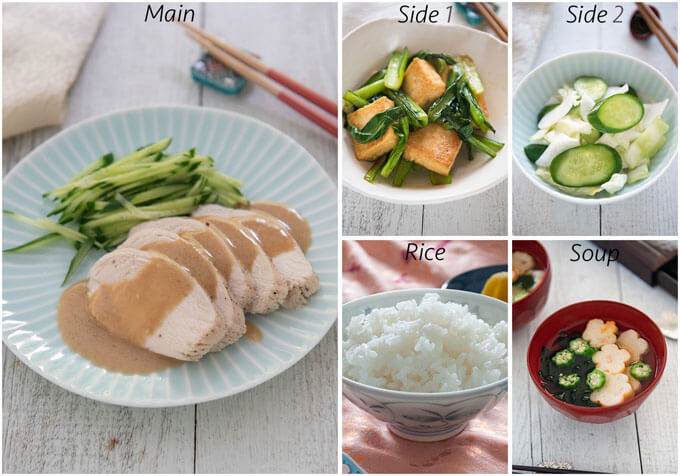My Home-Made Chicken Ham has a simple flavouring, but it is so juicy and tender that you won’t want to buy sliced chicken ham from supermarket anymore.
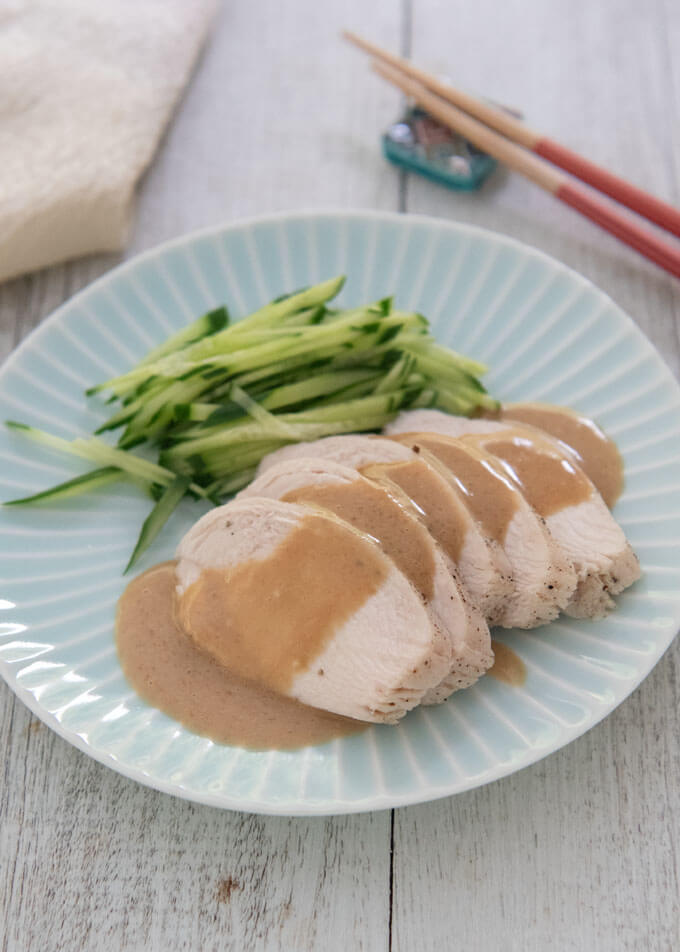
This Home-Made Chicken Ham is called ‘tori hamu’ (鶏ハム) in Japanese. The word ‘tori‘ (鶏) means chicken and ‘hamu‘ (ハム) is ham. It originated in Japan from a recipe posted on an anonymous Internet bulletin board in 2001.
Tori hamu is not like a pressed chicken ham. It is made from chicken breast fillet, and the process of making tori hamu is completely different from the commercial chicken ham. It is rather a sous vide chicken, but Japanese people call it chicken ham because the texture is similar to pressed chicken ham.
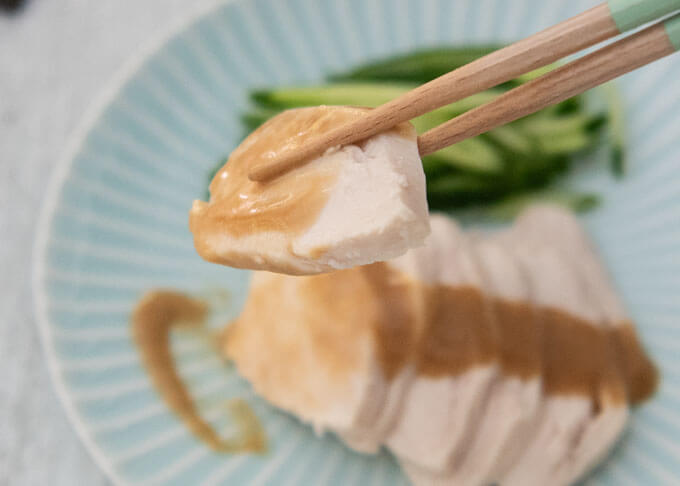
You Can Do Sous Vide Without a Special Tool
Sous vide is a cooking method of vacuum sealing food (usually meat and fish) and cooking it in temperature-controlled water (usually 55-71°C/130-160°F) for a longer than usual cooking time. You will get a piece of meat that is just cooked through, without losing moisture.
In the case of chicken, the recommended cooking temperature is 75°C/165°F, at which bacteria will be dead in 3 seconds. The reason you can still cook chicken at a lower temperature safely, e.g. sous vide, is that at 63°C /145°F for example, the time taken to kill bacteria is 10-15 minutes and you cook the chicken for much longer than that.
I don’t have a vacuum sealing machine or a sous vide machine. And the originator of Home-Made Chicken Ham did not have these machines either. So, I used a couple of primitive methods of mimicking sous vide.
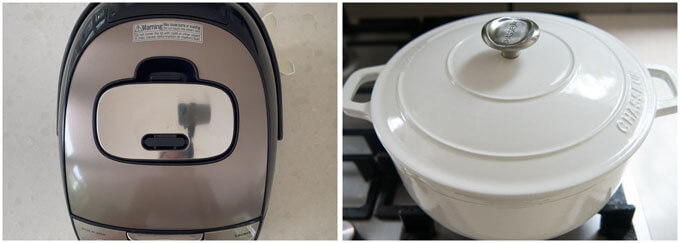
Method 1 – Use the Warm Mode feature of a rice cooker.
Method 2 – Use a thick bottomed large pot.
Without a machine, it is not easy to keep a consistent water temperature. The above method is not to keep the temperature consistent, but to start at a higher temperature and reduce the speed of losing the heat, resulting in the ideal temperature on average. The water temperature at the time of taking the chicken out was around 66°C /151°F.
It is quite easy to do, and the cooked chicken is very juicy.
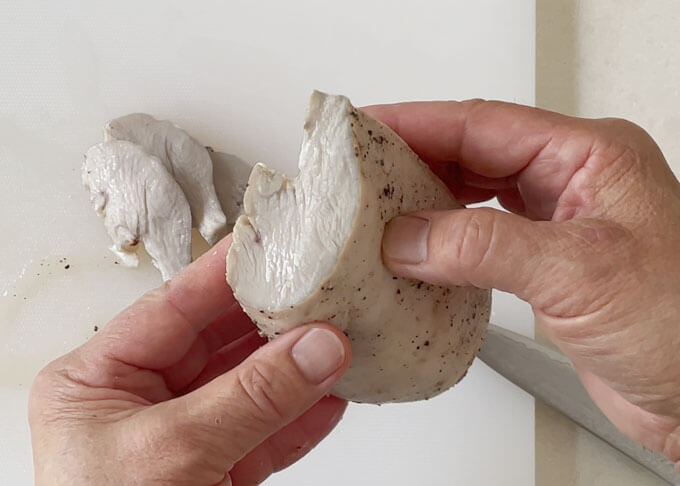
Although the chicken is lightly flavoured, you can enjoy more flavouring if you have it with a sauce such as ponzu, soy sauce, or sesame soy dressing. You can also eat it with a condiment such as mustard, wasabi, or rāyu. In today’s recipe, I included a sesame sauce that is made with a sesame paste.
What’s in My Home-made Chicken Ham
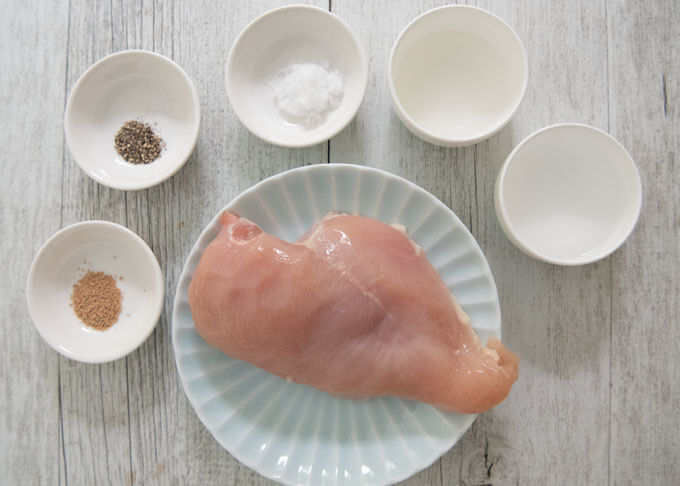
- Chicken breast fillet, without skin on
- Boiling water
My chicken fillet was 300g/0.7lb+. For 300-350g/0.7-0.8lb breast chicken fillet, you will need a minimum of 1500ml/3.2pt boiling water. If the volume of boiling water is less, the temperature of the water reduces too fast, and the chicken will not cook through.
You will also need to take the chicken out of the fridge at least 30 minutes before cooking to prevent the water temperature from lowering too fast.
Marinade
To give a good flavour to the chicken, I put the chicken in a dashi-flavoured marinade. If you are fond of herbs, you can add a small amount of dried basil or oregano.
- Cooking sake
- Water
- Salt
- Black pepper
- Dashi powder
Sesame Sauce
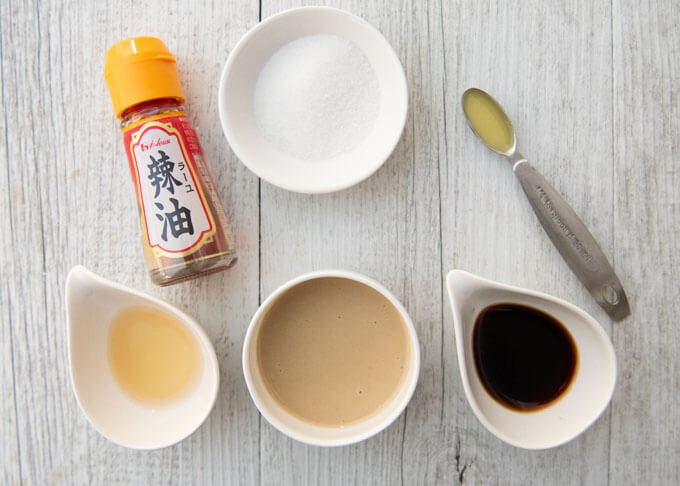
- White sesame paste
- Soy sauce
- Rice wine vinegar
- Sugar
- Ginger juice (squeeze the juice out of grated ginger)
- Rāyu (optional)
I used Carwari brand Japanese sesame paste, but you can use Chinese sesame paste or tahini. The Chinese sesame paste is darker in colour and the nutty flavour is stronger. Tahini is made from raw sesame seeds and the sesame flavour is not as strong as others.
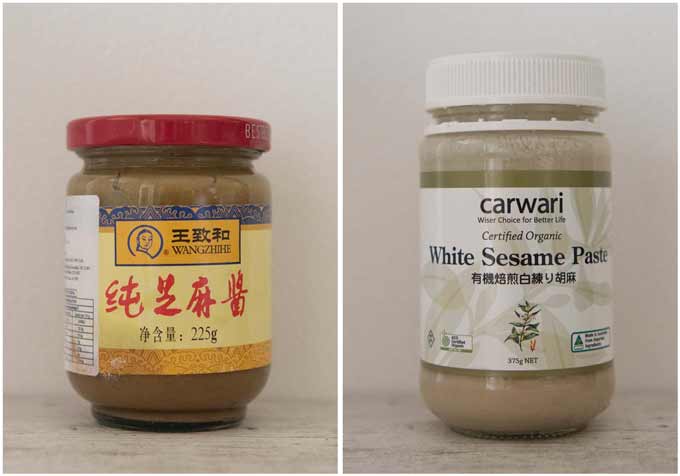
Left: Chinese sesame paste. Right: Carwari brand white sesame paste.
In addition to the above ingredients, you will need a zip lock bag, and either a rice cooker with the Warm Mode feature that can be turned on and off manually, or a thick-bottomed pot, depending on the method you use.
How to Make Home-made Chicken Ham (see the video)
It is important to take the chicken out of the fridge at least 30 minutes before cooking, so that the water temperature does not drop too much when the chicken is put in the water bath.
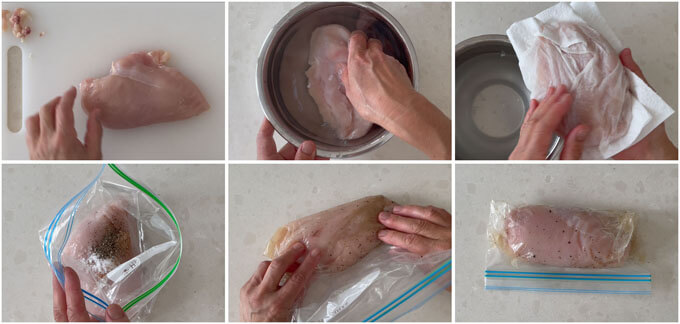
- Trim fat bits off the fillet and rinse it in a bowl filled with water. Pat dry.
- Put the chicken fillet and all the Marinade ingredients in a zip lock bag.
- Massage gently so that the marinade ingredients coat the fillet evenly.
- Remove air in the bag as much as possible and seal the bag.
- Use one of the following two methods to cook chicken.
Method 1 – use rice cooker:
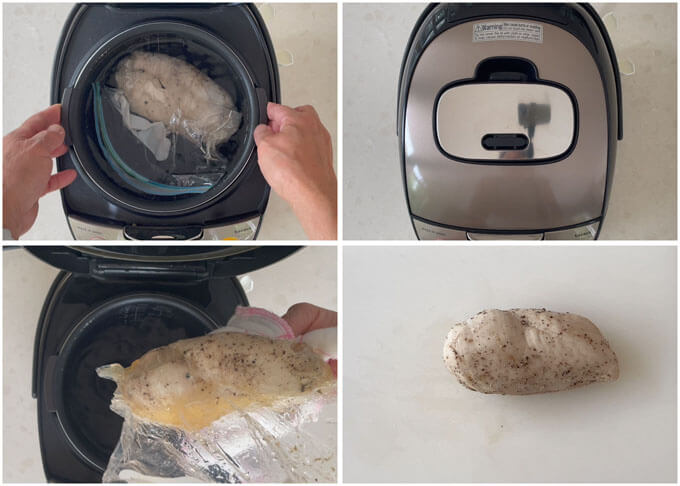
- Place the chicken in the inner bowl of the rice cooker, then pour the boiling water over the chicken to submerge the bag of chicken under water.
- Place the lid on and turn the switch for warm mode. Leave it on for 45 minutes.
- Remove the bag from the rice cooker, then remove the chicken from the bag.
Method 2 – use a thick-bottomed pot with a lid (not in video):
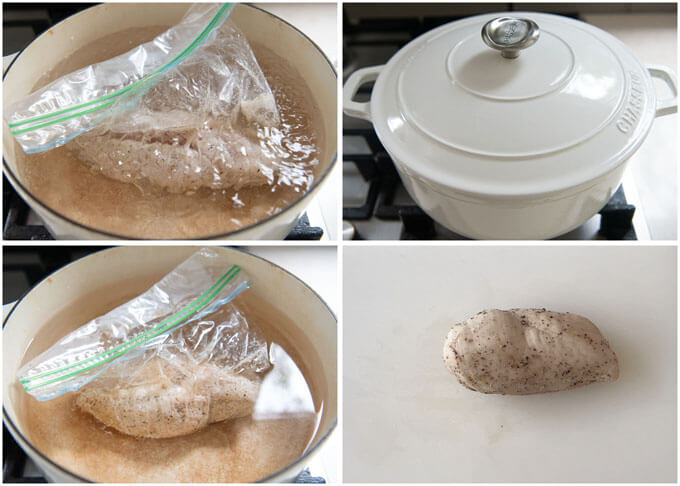
- Put the boiling water in a thick-bottomed pot and bring it to a boil over high heat.
- Gently submerge the bag of chicken under water.
- When the water starts boiling again, turn the heat off and put the lid on.
- Leave it for 1 hour.
- Remove the bag from the water, then remove the chicken from the bag.
Serving
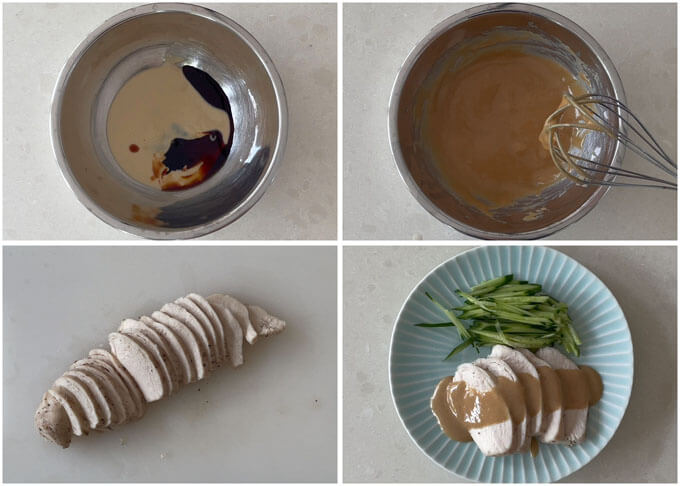
- Put the Sesame Sauce ingredients in a bowl and mix well.
- Slice the chicken thinly.
- Place the sliced chicken on a plate.
- Dribble the sesame sauce over the chicken.
It is best to eat the chicken as soon as you make it so that you get the juiciest chicken. You can keep it for 3-4 days in the fridge, but the longer you leave it the less juicy it gets.
After keeping the Tori Hamu for a couple of days in the fridge, I used the sliced chicken as a topping for a bowl of ramen. It was perfect!
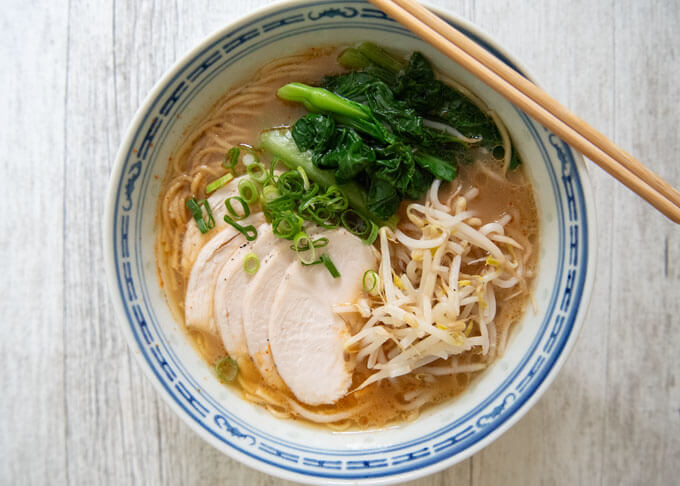
Yumiko![]()
Watch How To Make It

Home-made Chicken Ham Recipe (Tori Hamu)
My Home-Made Chicken Ham has a simple flavouring, but it is so juicy and tender that you won’t want to buy sliced chicken ham from supermarket anymore. It is not like a processed chicken ham but rather a sous vide chicken. But Japanese people call it ‘tori hamu’, meaning chicken ham, because the texture is similar to the pressed chicken ham (but better!). See the video.
I listed two different methods of making Tori Hamu.
Cook Time assumes a rice cooker is used.
Don’t forget to see the section ‘MEAL IDEAS’ below the recipe card! It gives you a list of dishes that I have already posted and this recipe that can make up a complete meal. I hope it is of help to you.
Recipe Type:
Main
Cuisine:
Japanese
Keyword:
Chicken breast recipe, chicken ham, home-made ham
Serves: 2
:
Ingredients (tbsp=15ml, cup=250ml)
-
1
chicken breast
(300-350g/0.7-0.8lb, skin off) -
1500-2000ml/3.2-4.2pt
boiling water
(note 1)
Instructions
Preparing Chicken
-
Trim off the string of fat and thin blood veins if they are on the surface of the chicken.
-
Put the chicken and all the Marinade ingredients in a zip lock bag.
-
Massage the bag well, ensuring that Marinade ingredients are mixed and have coated the meat evenly.
-
Remove as much air as possible out of the bag and seal it.
Making Tori Hamu (pick one of the two methods)
Method 1 – use a rice cooker with Warm Mode feature
-
Place the bag of chicken in the inner bowl of your rice cooker.
-
Add the boiling water to the inner bowl, ensuring that the chicken is submerged in water.
-
Close the rice cooker and turn the Warm Mode switch on. Leave it for 45 minutes.
-
Remove the bag from the water and take the chicken piece out of the bag (note 5).
Method 2 – use a thick bottomed pot
-
Put the boiling water in a pot over high heat, then place the bag in the water, ensuring that the whole chicken piece is submerged in the water.
-
When the water starts boiling again, turn the heat off. Place a lid on and leave it for 1 hour (don’t move the pot from the burner).
-
Remove the bag from the water and take the chicken piece out of the bag (note 5).
Serving
-
Cut the chicken into thin slices.
-
Place the sliced chicken on a serving plate, with julienned cucumbers or green salad (not in ingredients list).
-
Dribble the Sesame Sauce over the chicken.
Sesame Sauce (make sauce while cooking chicken)
-
Put sesame paste and soy sauce in a small bowl and mix well.
-
Add vinegar, sugar, and ginger juice to the bowl and mix well.
-
Add a few drops of rāyu (if using) and mix.
Recipe Notes
1. You need a minimum 1500ml/3.2pt of boiling water to cook a 300-350g/0.7-0.8lb breast fillet. If the water is less than this, the water temperature reduces too fast before the chicken gets cooked through.
My rice cooker needed 1800ml/3.8pt of boiling water to comfortably submerge the chicken in the water.
If you are using a pot, the quantity of water can vary depending on the size of your pot. For the 23cm/9 1⁄16″ saucepan that I used, I needed 2000ml/4.2pt water. If you use a smaller pot you can reduce the volume of boiling water, but no less than 1500ml/3.2pt.
If you are making 2 breast fillets of the similar size, you will need minimum 2000ml/4.2pt of boiling water.
2. If you are fond of herbs, you can add a small amount of basil or oregano.
3. I used Carwari brand sesame paste, but you can use Chinese sesame paste or tahini. Chinese sesame paste (see the sample photo in the post) is darker in colour and the nutty flavour is stronger. Tahini is made from raw sesame seeds and the sesame flavour is not as strong as others.
4. You can substitute rāyu with Chinese chilli oil.
5. The marinade has a good flavour and can be used to pour over the chicken instead of using the Sesame Sauce. Put the marinade through a sieve to remove chicken bits.
6. Nutrition per serving. It is assumed that 1/2 of the marinade is absorbed into the chicken.
Chicken without Sesame Sauce:
serving: 162g calories: 186kcal fat: 4g (5%) saturated fat: 0.9g (4%) trans fat: 0.0g polyunsaturated fat: 0.7g monounsaturated fat: 1.1g cholesterol: 110mg (37%) sodium: 660mg (29%) carbohydrates: 0.2g (0%) dietary fibre: 0g (0%) sugar: 0g protein: 34g vitamin D: 0mcg (0%) calcium: 9mg (1%) iron: 0.6mg ( 3%) potassium: 513mg (11%)
Sesame Sauce:
serving: 30g calories: 109kcal fat: 8g (10%) saturated fat: 1.1g (6%) trans fat: 0.0g polyunsaturated fat: 3.5g monounsaturated fat: 3g cholesterol: 0mg (0%) sodium: 297mg (13%) carbohydrates: 7.7g (3%) dietary fibre: 0.8g (3%) sugar: 4.2g protein: 3g vitamin D: 0mcg (0%) calcium: 23mg (2%) iron: 0.7mg (4%) potassium: 93.1mg (2%)
Meal Ideas
A typical Japanese meal consists of a main dish, a couple of side dishes, a soup and rice. I try to come up with a combination of dishes with a variety of flavours, colours, textures and make-ahead dishes.
Home-Made Chicken Ham is a diet-friendly dish with minimal fat contained in it. So, I came up with some dishes that do not add too many calories so that you can enjoy low-calorie meal, especially if you avoid sesame sauce to eat the ham.
Clear soups are lower calories than miso soups, if you are using the same ingredients in the soup. So, I picked a clear soup.
